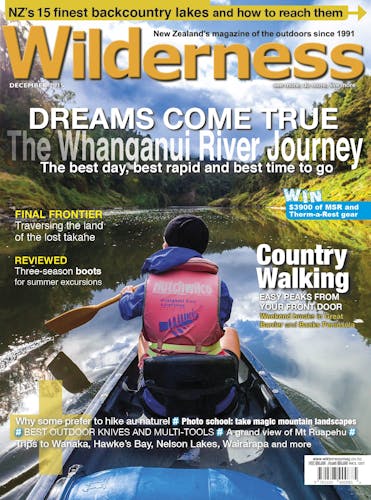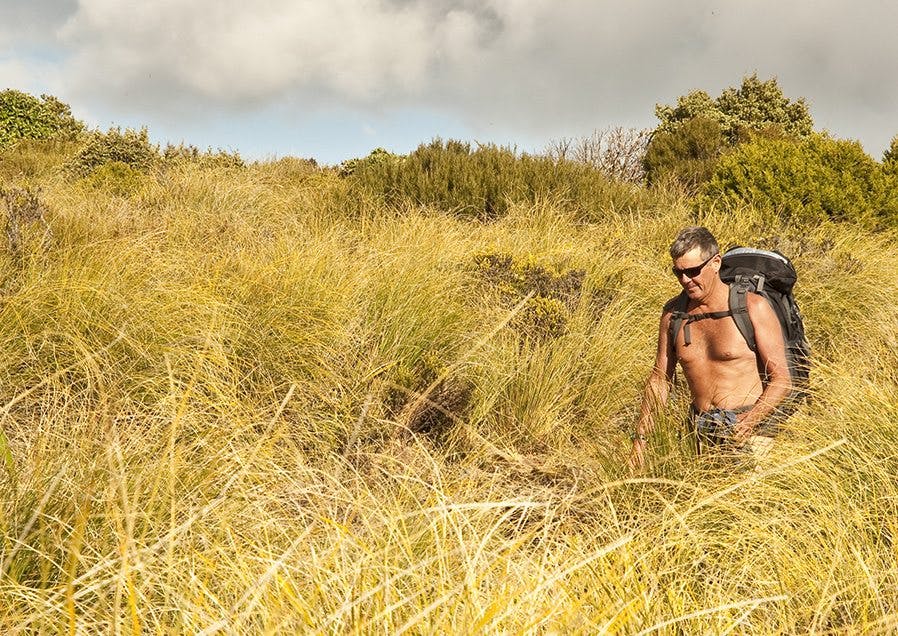The kiss of the sun’s warming rays on your skin is a simple pleasure, but how much skin is too much skin? Chris Maclean explains the appeal of tramping in the buff
What is it about nudity that interests people so much?
When Shaun Barnett and I were putting together our book Tramping, A New Zealand History, we suspected the section about nude tramping might provoke a response. But we had no idea it would have the media-mesmerising impact that it did.
No sooner was the book released than Campbell Live contacted our publicist, asking if we were prepared to tramp nude for their cameras.
“No, we weren’t,” we replied.
Then our publisher suggested a nude tramp to garner publicity for the book. Again, we refused.
A few weeks later, we were invited to ‘Play Favourites’ with Kim Hill on her Radio New Zealand programme. Our conversation with her proceeded smoothly, once we had persuaded her that tramping wasn’t all pain and suffering, when she interrupted her planned questioning to ask us about tramping naked. Someone had rung the show while we were on air to suggest she ‘ask Chris about nude tramping’.
And with great glee she did. In some detail. For days afterwards friends, family, and even neighbours let me know they now saw me in a different light.
So what is nude tramping and who does it? Well, I do and so do a few other trampers, but it’s very much a minority pursuit. It is a great feeling, an invigorating experience that is sensual rather than sexual; it’s about wind on the skin while sauntering along the tussock tops or the warmth of the sun on your body while tramping down a riverbed. Sometimes walking, sometimes swimming.
Yet I don’t get to tramp nude as often as I would like because favourable circumstances are rare. Obviously, the weather needs to be conducive. Shedding clothes is easy when it’s fine and warm but neither pleasant nor practical when it’s windy or wet. That drastically limits opportunities in New Zealand’s tempestuous climate.
Then you have to be in the right place at the right time. Nude tramping on a bush track is risky, as other walkers can suddenly appear, leaving no time to get your shorts on.
It’s better done on a fine day on the tops when you can see people approaching from up to a kilometre away.
This is important because the legality, or otherwise, of nude tramping is unclear. Public nudity that offends others can be viewed as a criminal offence. A man made the headlines a few years ago for riding a bike in the nude, but because no one complained, the police took no action other than to issue him a warning for not wearing a helmet!
In the bush or the hills, the prospect of running into children or others who may be offended is a real risk, although my greater worry is encountering homophobic hunters who might just be tempted to dispense with this ‘insult to Kiwi blokes’ Either way, a degree of caution is advisable.
To enjoy nude tramping, you must be relaxed and if you are worried about encountering others, it’s best to stay dressed. But there are vast areas of the backcountry where, chances are, you won’t meet anyone. And you can often sense this intuitively.
Timing helps. Weekdays are often good, but weekends in the hills are more popular, and the same applies to public holidays, so some reticence may be required at such times. I climbed Nelson’s popular Mt Arthur some years ago in the nude on a weekday and encountered no one. Yet, when I returned several months later on a Saturday during the summer holidays, I kept my clothes on – a sensible precaution as so many people crowded the summit that it resembled a cocktail party.
Climbing Mt Arthur can be easily achieved in a day, meaning you only need a day pack. Tramping nude with a much heavier pack can be uncomfortable as the straps and waist belt dig into unprotected flesh.
Then there’s the need for sun protection, especially for body parts not usually exposed. In our book, we described how in the 1930s the young Auckland student Elsie Locke (later to become a prominent peace activist), got sunburned in some unusual places while tramping nude in the Waitakeres.
During that decade, it was student Ormond Wilson who introduced nude tramping to New Zealand. Before the war, he had studied in England and travelled extensively in Germany, where nudity in the outdoors is much more common. When he returned to New Zealand, Wilson introduced the idea to fellow progressives such as Bill Sutch and his partner Morva Williams.
Although it has always remained a minority practice here, it is so much more common in Europe that when the Swiss recently got fed up with so many Germans tramping nude in their mountains, the Germans responded by developing an 18km nude tramping trail in the Harz Mountains. There, clothed walkers are the oddity!
Wherever it occurs, nude tramping is an activity that goes beyond sensuality to evoke the essence of being in the outdoors.
We concluded the section on naked tramping in our tramping history with these thoughts from Otago writer and outdoorsman, Brian Turner: ‘When some trampers shed their clothes in the mountains and jumped into clear cold pools, I always got the feeling that they were shedding more than just garments. This was a ‘statement’, a nod to Adam’s nakedness when he was created. Getting back to nature improved one’s chances of salvation. It was also just bloody great to feel so fully alive. If this wasn’t freedom, what was?’







